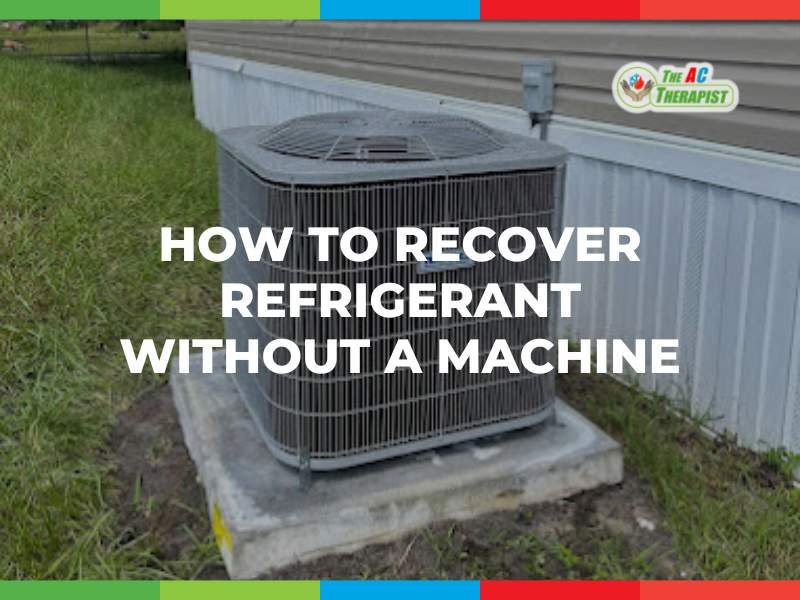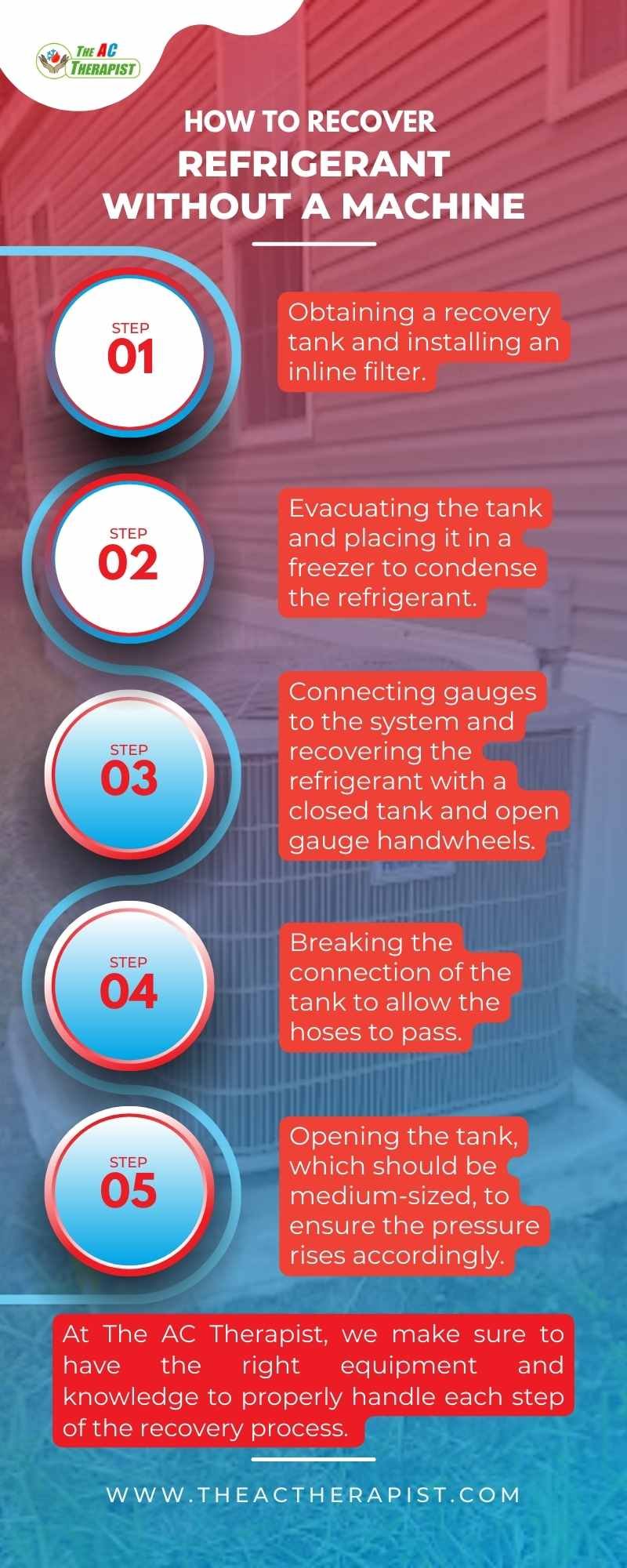How to Recover Refrigerant Without a Machine
Refrigerant is a substance or mixture typically found either in a fluid or vapor state and used in a heat pump and refrigeration cycle. Without refrigerants, there is no way air conditioning, refrigeration, and freezing technology exist.
With the institution of the Clean Air Act of 1990, refrigerant recovery has now been strict since it is becoming the reason for ozone layer depletion. So it is essential to recover refrigerants from time to time.
In this blog post, we’ll be diving into the process of refrigerant recovery and explaining the key steps involved in the process.
From obtaining the necessary equipment to ensuring that the recovered refrigerant is stored safely, we’ll cover everything you need to know about refrigerant recovery.
Whether you’re a professional HVAC technician or a homeowner, this post will provide valuable information on how to properly recover refrigerant and ensure that the job is done safely and efficiently.
Disclaimer, do not use this information to perform many tasks on your air conditioner. This is our opinion, not advice for you to follow. Seek advice from a professional and licensed HVAC company.
You might want to read: 5 Essential Tips to select the Right HVAC contractor
Refrigerant Recovery Without a Machine? How?
In order to recover refrigerant without a machine, you must first obtain the Environmental Protection Agency (EPA) section 608 Technician Certification.
Under this section, technicians are required to pass the EPA-approved test to earn Section 608 Technician Certification. This certification will allow them to maintain, repair, dispose of, or service equipment that could release refrigerants into the atmosphere.
Any technician must obtain one of the four types of certification:
- Type I – Small Appliances Services
- Type II – High-pressure Appliances Services
- Type III – Low-pressure Appliances Services
- Universal – All types of equipment Services
HVAC professionals can solve your air conditioning problems from smallest to biggest, with their proper set of equipment and machines. Always make sure to have the proper licenses and equipment to do the job or when hiring someone to service your HVAC system.
Gauges and Tanks: Refrigerant Recovery Process
Step 1. Get a recovery tank, then put an inline filter.
The first step is to obtain a recovery tank. This tank is specially designed to hold and store the recovered refrigerant.
It is important to ensure that the tank is of the appropriate size and meets the safety regulations. The second step in this step is to put an inline filter.
The inline filter is placed between the recovery tank and the hose that will be used to recover the refrigerant. This filter removes any debris or impurities that may be present in the refrigerant, making sure that the recovered refrigerant is clean and safe to use.
It’s important to be sure that the filter is compatible with the type of refrigerant used in the system. The AC Therapy team has the right equipment and know-how to properly handle this step.
Step 2. Evacuate the tank and place it in a freezer. If the tank is not evacuated, there is a big possibility that the air may mix with the refrigerant you are trying to recover.
This is done to ensure that all the air inside the tank is removed and that the recovered refrigerant can condense properly.
Failing to evacuate the tank before placing it in the freezer can lead to the mixing of air with the refrigerant, which can negatively impact the effectiveness of the recovery process.
The AC Therapist team follows the proper protocols and uses the appropriate equipment to evacuate the tank and ensure that the recovered refrigerant is clean and pure.
Once the tank is evacuated, it is placed in a freezer, where the refrigerant can condense and be ready for the next step in the recovery process.
Step 3. Connect the gauges to the system, then recover the tank with the closed tank and open the gauge handwheels.
The gauges are used to measure the pressure of the refrigerant in the system and to ensure that the recovery process is proceeding as it should.
Once the gauges are connected, the recovery tank is closed and the gauge handwheels are opened, allowing the refrigerant to flow into the recovery tank.
It’s important to monitor the pressure and make sure that the recovery process is done safely and that the refrigerant is being recovered at the appropriate rate.
The AC Therapist team uses industry-standard gauges to measure the pressure and make sure that the recovery process is done correctly.
Step 4. Brake the connection of the tank so there is a way for the hoses to pass.
This step is done to allow the hoses to pass through the system and to separate the recovery tank from the system being serviced.
Breaking the connection with the tank is an important step that allows the recovery process to proceed smoothly and safely.
It’s important to properly disconnect the recovery tank from the system without causing any damage to the equipment or compromising the safety of the process.
Once the connection is broken, the hoses are passed through the system, and the recovery process continues.
Step 5. Open the tank – should be medium in size so that when the pressure rises, it will go accordingly.
This step is done to ensure that the recovered refrigerant is properly stored and ready for use.
It’s important to use a medium-sized tank for this step so that when the pressure rises, it will go accordingly.
A tank that is too small can cause the pressure to build up too quickly, which can be dangerous, while a tank that is too large may not allow the pressure to build up at all.
By using a medium-sized tank, we can ensure that the pressure rises at the appropriate rate and that the recovered refrigerant is stored safely. Once the tank is opened, the recovered refrigerant is ready to be used or recycled.
The AC Therapist team will follow the proper protocols and regulations to handle the recovered refrigerant, ensuring that it is safe to use and environmentally friendly.
Refrigerant Recovery: Keep This in Mind
For the refrigerant recovery to be successful, the tank you will be using should be cold so that all the refrigerants going inside it can condense properly. If the air is existing inside the tank, there is a possibility that the whole process will not be effective as you expected, so keep in mind to vacuum the air correctly.
If you are operating a refrigerant recovery or any HVAC-related tasks, safety is the most and primary thing that should be on the list.
The person involved in any HVAC activity, especially refrigerant recovery must wear safety glasses and high-quality gloves to avoid possible frostbite. At the time of every refrigerant recovery, follow the instructions step by step. Taking shortcuts may harm you and both your equipment.
The AC Therapist: Your HVAC Partner
At The AC Therapist, our team of certified HVAC professionals is trained and certified in the proper techniques for refrigerant recovery without the need for a machine.
Our technicians are EPA Section 608 certified, ensuring that they have passed the necessary tests to maintain, repair, dispose of, or service equipment that could release refrigerants into the atmosphere.
We understand the importance of safety and efficiency in refrigerant recovery, which is why our technicians are equipped with the necessary gauges and tanks, as well as the proper safety gear.
Trust The AC Therapist to handle all of your refrigerant recovery needs and ensure the job is done correctly and safely.
Keeping your HVAC system running to its optimal stage is our top priority – helping to have an efficient and effective air conditioning system all year long.
If you have any related questions and concerns regarding refrigerant recovery, contact The AC Therapist at (813)-343-2212 to set up an appointment with us for HVAC repair in Tampa. You have to experience care for your heat and air.










